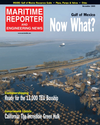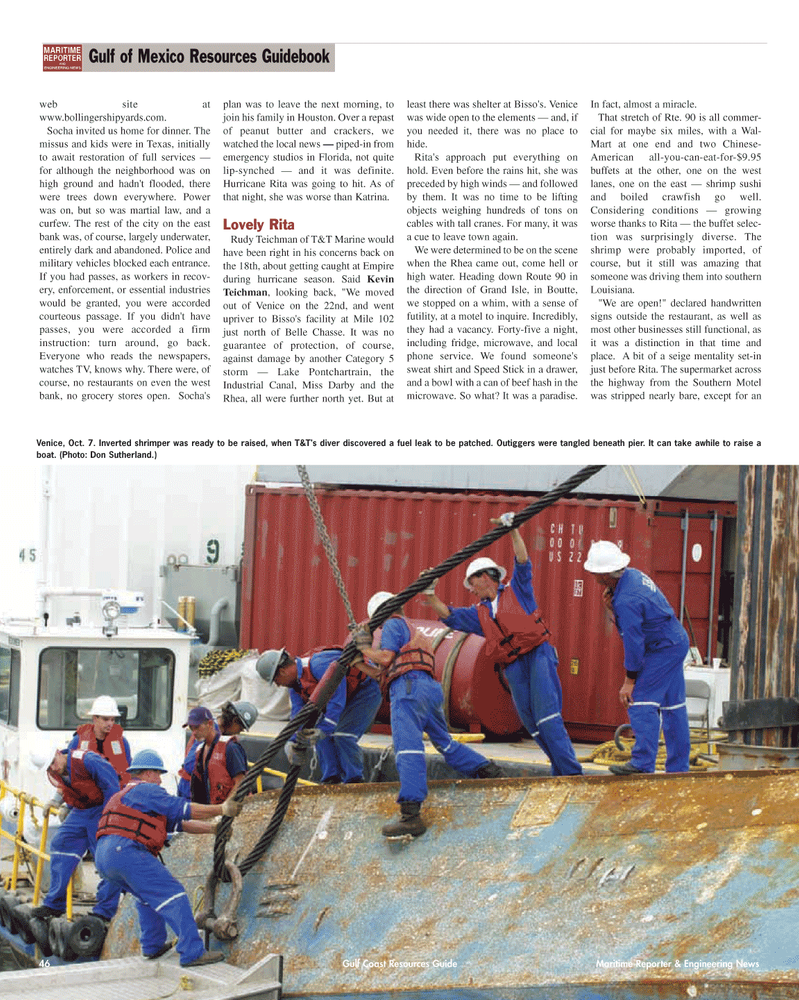
Page 46: of Maritime Reporter Magazine (November 2005)
The Workboat Annual Edition
Read this page in Pdf, Flash or Html5 edition of November 2005 Maritime Reporter Magazine
web site at www.bollingershipyards.com.
Socha invited us home for dinner. The missus and kids were in Texas, initially to await restoration of full services — for although the neighborhood was on high ground and hadn't flooded, there were trees down everywhere. Power was on, but so was martial law, and a curfew. The rest of the city on the east bank was, of course, largely underwater, entirely dark and abandoned. Police and military vehicles blocked each entrance.
If you had passes, as workers in recov- ery, enforcement, or essential industries would be granted, you were accorded courteous passage. If you didn't have passes, you were accorded a firm instruction: turn around, go back.
Everyone who reads the newspapers, watches TV, knows why. There were, of course, no restaurants on even the west bank, no grocery stores open. Socha's plan was to leave the next morning, to join his family in Houston. Over a repast of peanut butter and crackers, we watched the local news — piped-in from emergency studios in Florida, not quite lip-synched — and it was definite.
Hurricane Rita was going to hit. As of that night, she was worse than Katrina.
Lovely Rita
Rudy Teichman of T&T Marine would have been right in his concerns back on the 18th, about getting caught at Empire during hurricane season. Said Kevin
Teichman, looking back, "We moved out of Venice on the 22nd, and went upriver to Bisso's facility at Mile 102 just north of Belle Chasse. It was no guarantee of protection, of course, against damage by another Category 5 storm — Lake Pontchartrain, the
Industrial Canal, Miss Darby and the
Rhea, all were further north yet. But at least there was shelter at Bisso's. Venice was wide open to the elements — and, if you needed it, there was no place to hide.
Rita's approach put everything on hold. Even before the rains hit, she was preceded by high winds — and followed by them. It was no time to be lifting objects weighing hundreds of tons on cables with tall cranes. For many, it was a cue to leave town again.
We were determined to be on the scene when the Rhea came out, come hell or high water. Heading down Route 90 in the direction of Grand Isle, in Boutte, we stopped on a whim, with a sense of futility, at a motel to inquire. Incredibly, they had a vacancy. Forty-five a night, including fridge, microwave, and local phone service. We found someone's sweat shirt and Speed Stick in a drawer, and a bowl with a can of beef hash in the microwave. So what? It was a paradise.
In fact, almost a miracle.
That stretch of Rte. 90 is all commer- cial for maybe six miles, with a Wal-
Mart at one end and two Chinese-
American all-you-can-eat-for-$9.95 buffets at the other, one on the west lanes, one on the east — shrimp sushi and boiled crawfish go well.
Considering conditions — growing worse thanks to Rita — the buffet selec- tion was surprisingly diverse. The shrimp were probably imported, of course, but it still was amazing that someone was driving them into southern
Louisiana. "We are open!" declared handwritten signs outside the restaurant, as well as most other businesses still functional, as it was a distinction in that time and place. A bit of a seige mentality set-in just before Rita. The supermarket across the highway from the Southern Motel was stripped nearly bare, except for an
Gulf of Mexico Resources Guidebook
MARITIME
REPORTER
AND
ENGINEERINGNEWS 46 Gulf Coast Resources Guide Maritime Reporter & Engineering News
Venice, Oct. 7. Inverted shrimper was ready to be raised, when T&T's diver discovered a fuel leak to be patched. Outiggers were tangled beneath pier. It can take awhile to raise a boat. (Photo: Don Sutherland.)
MR NOVEMBER 2005 #6 (41-48).qxd 10/28/2005 2:46 PM Page 46

 45
45

 47
47
